



Water-Cooled Perches Benefit Broilers in Summer
CHINA - Researchers in Shandong have found that water-cooled perches were preferred by broilers during hot weather and were associated with a number of performance, meat quality and welfare benefits. Standard perches seemed to offer none of these advantages.A study was conducted by J. P. Zhao and colleagues at Shandong Agricultural University to determine whether water-cooled perches would be preferred by commercial broilers exposed to a hot ambient environment, and subsequently, whether utilization of these perches would improve performance and the well-being of birds, beyond those provided by normal perches.
In the latest issue of Poultry Science, they report using 432 14-day-old male chickens from a commercial fast-growing strain (Arbor Acres), housed in the following conditions:
- cool perches
- normal perches, or
- control pens with no perches.
The results showed that there was greater use of cool perches than normal perches for broiler chickens during summer.
Cool perches increased bodyweight gain and breast and thigh muscle yields, while decreasing abdominal fat deposition, cooking loss, percentage of panting birds and scores of footpad and hock burns as well as abdominal plumage condition, particularly toward the end of the rearing period.
In contrast, normal perches hardly affected growth performance, carcass composition, meat quality and behavioural patterns, and appeared to worsen the welfare status, including footpad and hock burns and abdominal plumage condition, due to a lower occupancy rate.
Cool perches offer a thermoregulatory and performance advantage to broilers exposed to a hot environment, according to the Shandong researchers, as well as appearing to be a management strategy for improving the production and well-being of commercial broilers.
Reference
Zhao J.P/. H.C. Jiao, Y.B. Jiang, Z.G. Song, X.J. Wang and H. Lin. 2012. Cool perch availability improves the performance and welfare status of broiler chickens in hot weather. Poult. Sci. 91(8):1775-1784. doi: 10.3382/ps.2011-02058
Further ReadingYou can view the full report (fee payable) by clicking here. |








